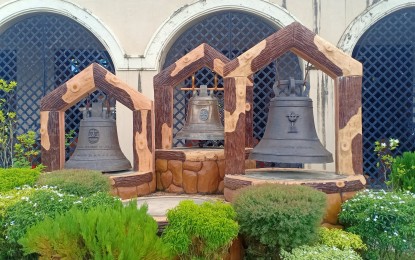From the Philippine News Agency (Jul 22, 2021): Return of Balangiga bells sparks growth in Eastern Samar town (By Sarwell Meniano)

TOURIST ATTRACTION. The three returned bells are displayed outside the church in Balangiga, Eastern Samar. More than two years after the return of Balangiga bells, the town continues to reap the benefits from this historic event, said Fe Campanero, Balangiga tourism officer on Thursday. (July 22, 2021). (Photo courtesy of Emy Calagos)
TACLOBAN CITY – More than two years after the return of Balangiga Bells, the town of Balangiga in Eastern Samar continues to reap the benefits from this historic event.
Tourism-related businesses have popped up, accommodation facilities have been improved while roads leading to upland eco-tourism sites have been paved since 2019, Fe Campanero, Balangiga tourism officer, said in a phone interview Thursday.
“Since the return of bells, our visitor arrivals went up, especially before the pandemic. From just 2,000 visitors in the entire 2017, the number has increased to 100,000 from December 2018 to June 2019 alone,” Campanero told the Philippine News Agency (PNA).
Since last year, the town has been welcoming up to 300 visitors weekly.
The official said that visitors from different parts of Eastern Samar and Eastern Visayas were eager to see the bells taken by American soldiers in 1901 and kept for 117 years until it was returned to the town in December 2018.
There were several attempts to negotiate for the return of the three looted bells with two displayed at a museum in Fort Russell, Wyoming, USA, and another at a museum in South Korea.
During his State of the Nation Address on July 24, 2017, President Rodrigo Duterte demanded the return of the bells as it serves as "reminders of the gallantry and heroism of our forebears who resisted the American colonizers."
"Give us back those Balangiga bells. They are ours. They belong to the Philippines. They are part of our national heritage," Duterte said.
The US government finally agreed to return the bells in August 2018 when US Defense Secretary James Mattis signed an official document agreeing to deliver back the wartime artifacts. The bells arrived in Manila on Dec. 11 that same year.
Duterte witnessed on Dec. 15, 2018 the turnover of the Transfer Certificate of the Balangiga Bells from US Deputy Chief of Mission John Law to Philippine Department of National Defense Secretary Delfin Lorenzana. The certificate was then handed over to the local government of Balangiga.
In his speech during the handover, the President said that the return of the bells was made possible due to "several efforts made by both Americans and the Philippines."
For locals, the bells’ return has created a lot of economic opportunities in Balangiga, a fourth-class town in Eastern Samar and home to 14,341 people.
“The return of these bells has sparked development in our town. Owners of our lodging house have invested in improving their facilities, a souvenir shop was set up, and locals have invested in opening coffee shops. It also encouraged investors to open motorcycle shops and a home appliance center in our town,” Campanero added.
In the past, residents have to take a 97-kilometer trip to Tacloban City or a 115-kilometer ride to Borongan City to buy a motorcycle or an appliance.
Between 2018 to 2019, the Department of Agriculture also poured funds to build farm-to-market roads leading to the villages of Sta. Rosa, Cag-olango, Guinmaayohan. These areas are also identified for eco-tourism activities.
In 2018, the tourism department also conducted community guiding training for the Balangiga historical tour stakeholders.
“Aside from these economic gains, the return of bells has also helped locals learn and love local history as well as appreciate our country’s ties with the US government,” Campanero added.
Balangiga town is known for the Balangiga Encounter that happened on Sept. 28, 1901, when residents, led by Valeriano Abanador, initiated an attack against US soldiers.
The villagers killed 54 American soldiers using bolos. It was the biggest defeat of the foreign troops during the Philippine-American war.
In retaliation, the US soldiers attacked the town, killing anyone who could carry firearms, and took the Balangiga bells.
https://www.pna.gov.ph/articles/1147915

No comments:
Post a Comment
Note: Only a member of this blog may post a comment.